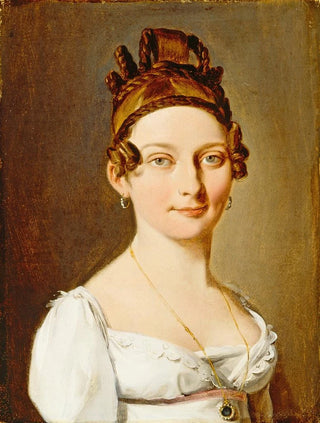Art print | Portrait of a lady - Louis Léopold Boilly


View from behind

Frame (optional)
Louis Léopold Boilly's "Portrait of a Lady" is a work that embodies the elegance and subtlety of early 19th-century portraits. This painting, which captures the timeless beauty of a woman, transports us into a universe where fashion, customs, and the nuances of bourgeois life come to life. Through this portrait, Boilly does not merely depict a female figure; he invites us to explore a world of delicacy and refinement, where every detail matters. The soft light illuminating the lady's face, the rich textures of her clothing, and the expression in her eyes create an intimate and captivating atmosphere.
Style and uniqueness of the work
Boilly's style is characterized by an exceptional mastery of color and light. In "Portrait of a Lady," he uses warm tones and delicate shadows to bring his subject to life. The composition is carefully thought out, with a neutral background that highlights the central figure. The lady's posture, both graceful and natural, reflects a sensitivity to the psychology of the characters he depicts. Every element of the canvas, from the choice of clothing to accessories, is meticulously crafted to reflect not only the social status of the protagonist but also her character. Boilly succeeds in capturing a moment of intimacy, a suspended instant in time, where one can almost hear the whisper of conversations surrounding her.
The artist and his influence
Louis Léopold Boilly is often regarded as one of the pioneers of realism in painting. Active at the end of the 18th century and the beginning of the 19th century, he established himself through his ability to depict everyday life with remarkable precision. His work reflects a time of great change, where bourgeois values emerge and art begins to focus more on individuals than on historical or mythological subjects. Boilly influenced many artists who followed, notably through his approach to portraiture and his way of capturing human essence. His legacy is reflected in later artistic movements, where individuality and personal expression take precedence over academic conventions.
Wall decoration

Matte finish

View from behind

Frame (optional)
Louis Léopold Boilly's "Portrait of a Lady" is a work that embodies the elegance and subtlety of early 19th-century portraits. This painting, which captures the timeless beauty of a woman, transports us into a universe where fashion, customs, and the nuances of bourgeois life come to life. Through this portrait, Boilly does not merely depict a female figure; he invites us to explore a world of delicacy and refinement, where every detail matters. The soft light illuminating the lady's face, the rich textures of her clothing, and the expression in her eyes create an intimate and captivating atmosphere.
Style and uniqueness of the work
Boilly's style is characterized by an exceptional mastery of color and light. In "Portrait of a Lady," he uses warm tones and delicate shadows to bring his subject to life. The composition is carefully thought out, with a neutral background that highlights the central figure. The lady's posture, both graceful and natural, reflects a sensitivity to the psychology of the characters he depicts. Every element of the canvas, from the choice of clothing to accessories, is meticulously crafted to reflect not only the social status of the protagonist but also her character. Boilly succeeds in capturing a moment of intimacy, a suspended instant in time, where one can almost hear the whisper of conversations surrounding her.
The artist and his influence
Louis Léopold Boilly is often regarded as one of the pioneers of realism in painting. Active at the end of the 18th century and the beginning of the 19th century, he established himself through his ability to depict everyday life with remarkable precision. His work reflects a time of great change, where bourgeois values emerge and art begins to focus more on individuals than on historical or mythological subjects. Boilly influenced many artists who followed, notably through his approach to portraiture and his way of capturing human essence. His legacy is reflected in later artistic movements, where individuality and personal expression take precedence over academic conventions.
Wall decoration






